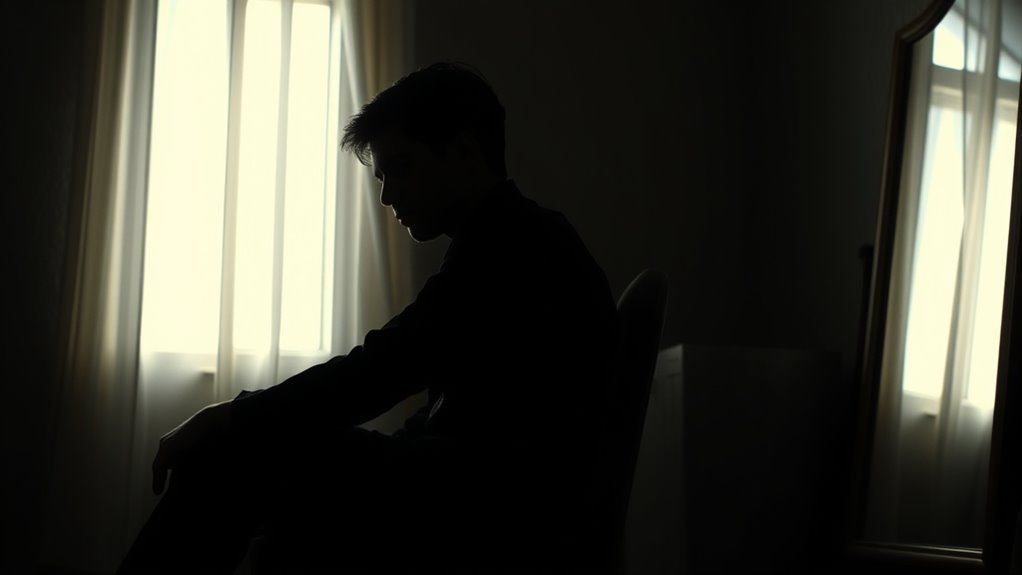To safely embrace your dark side, start by building emotional safety through practices like meditation or therapy to create a secure space. Next, recognize and understand shadow traits and patterns by journaling triggers and reactions. Then, cultivate compassion by visualizing your inner child and engaging in gentle dialogue to foster healing. Finally, commit to ongoing self-awareness and acceptance, knowing this journey is continuous. If you continue, you’ll uncover more ways to deepen your shadow integration process.
Key Takeaways
- Cultivate self-compassion and patience to gently explore and accept your shadow aspects without judgment.
- Identify recurring emotional patterns to uncover hidden shadow traits and unresolved inner child wounds.
- Use visualization and inner dialogue to safely confront and integrate dark or uncomfortable parts of yourself.
- Create a supportive environment through meditation, therapy, or quiet reflection to facilitate emotional safety.
- Commit to ongoing self-awareness and healing, understanding shadow work is a continuous journey of growth.

Have you ever wondered what lies beneath your conscious awareness? Beneath the surface of your daily thoughts and actions, there’s a part of you often hidden—your shadow. This shadow holds the parts of yourself you might not want to face: fears, anger, shame, or even unresolved pain. Embracing this dark side isn’t about self-criticism or dwelling on negativity. Instead, it’s about understanding and integrating these aspects to foster emotional healing and create a more authentic self. One way to start this process is by reconnecting with your inner child. Your inner child represents the vulnerable, unguarded part of you that holds the raw emotions and experiences from your past. When you work on healing this inner child, you begin to clear the emotional baggage that fuels your shadow. Emotional healing becomes a essential step because it allows you to confront and process feelings you might have suppressed or avoided. Through this, you create a safe space where your emotional wounds can be acknowledged and soothed.
To proceed, you need to develop awareness of your shadow traits. Pay attention to recurring patterns or reactions that seem disproportionate—anger over small issues, guilt that lingers, or feelings of shame. These often signal unresolved parts of your inner child or unconscious beliefs that need attention. Journaling can be a powerful tool here, helping you track triggers and understand the origins of these feelings. As you explore these reactions, remind yourself that your shadow isn’t inherently evil or wrong—it’s a part of you that’s been pushed aside to protect your vulnerable inner child. Embracing this part requires compassion and patience. You might visualize your inner child and have a gentle dialogue, reassuring that you’re now ready to face and integrate these hidden aspects.
Creating a safe environment for emotional healing is essential. This could involve meditation, therapy, or simply setting aside quiet time to reflect. When you allow yourself to feel and accept uncomfortable emotions without judgment, you begin to dismantle the walls that keep your shadow hidden. Through consistent practice, you’ll notice your reactions becoming more balanced, and your understanding of yourself deepening. Remember, shadow integration isn’t a one-time event; it’s a continuous journey of self-discovery, healing, and acceptance. As you nurture your inner child and face your shadow with kindness, you’ll find that your emotional landscape becomes richer, more authentic, and ultimately, more free. Embracing your dark side in this way empowers you to live with greater clarity and genuine self-awareness.
Frequently Asked Questions
How Do I Recognize My Shadow Traits?
You recognize your shadow traits by becoming aware of projection; when you see others’ flaws, it often reflects your hidden fears. Pay attention to emotional triggers and recurring negative patterns, as they reveal parts of yourself you’d rather ignore. By observing these reactions without judgment, you deepen your projection awareness, helping you identify traits you’ve suppressed. Embracing this process allows you to understand and integrate your shadow safely.
Can Shadow Work Improve My Relationships?
Think of your relationships as a garden, and shadow work as tending its hidden corners. By increasing your emotional awareness and practicing self-acceptance, you uncover and heal underlying wounds. This process helps you communicate more honestly and empathize deeply with others. As you embrace your shadow, you create space for genuine connections, reducing misunderstandings and fostering trust. Shadow work truly transforms your relationships into a thriving, harmonious garden.
What Are Common Mistakes in Shadow Integration?
When you explore shadow integration, watch out for projection pitfalls, where you blame others instead of your own issues, and suppression risks, which can cause your dark side to resurface unexpectedly. It’s common to rush or avoid confronting uncomfortable truths, but doing so hampers growth. Instead, face your shadow with patience and honesty, ensuring you don’t project or suppress important aspects of yourself. This keeps your journey safe and effective.
Is Shadow Work Suitable for Everyone?
Like a delicate dance, shadow work isn’t for everyone. You need strong personal boundaries and emotional resilience to navigate its depths safely. If you’re prone to intense emotional upheaval or unresolved trauma, diving in might do more harm than good. It’s essential to assess your mental health and readiness before setting out on this journey. Consulting a mental health professional can help determine if shadow work suits your current emotional landscape.
How Long Does the Shadow Integration Process Take?
The timing considerations for shadow integration vary based on your emotional readiness and personal pace. It could take weeks, months, or even longer, depending on how deep your work goes. You’ll want to make certain you’re emotionally prepared, allowing yourself space to process feelings safely. Rushing can hinder progress, so listen to your intuition and give yourself time to gradually embrace your dark side without feeling overwhelmed.
Conclusion
So, there you have it—embracing your dark side might just be the most enlightening thing you ever do. Who knew that facing your shadows could lead to greater self-awareness and peace? Ironically, by accepting your flaws, you might finally feel whole. So go ahead, step into the darkness with confidence—after all, it’s the only way to truly see the light. Embrace your shadows; they’re your secret superpower.










